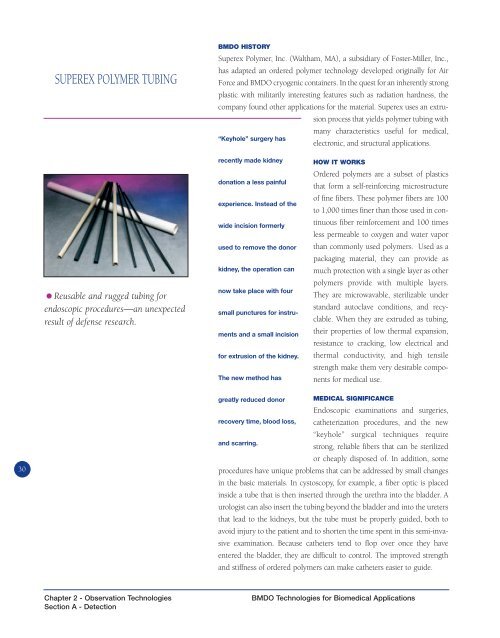bmdo technologies for biomedical applications - MDA Technology
bmdo technologies for biomedical applications - MDA Technology
bmdo technologies for biomedical applications - MDA Technology
You also want an ePaper? Increase the reach of your titles
YUMPU automatically turns print PDFs into web optimized ePapers that Google loves.
SUPEREX POLYMER TUBINGBMDO HISTORYSuperex Polymer, Inc. (Waltham, MA), a subsidiary of Foster-Miller, Inc.,has adapted an ordered polymer technology developed originally <strong>for</strong> AirForce and BMDO cryogenic containers. In the quest <strong>for</strong> an inherently strongplastic with militarily interesting features such as radiation hardness, thecompany found other <strong>applications</strong> <strong>for</strong> the material. Superex uses an extrusionprocess that yields polymer tubing withmany characteristics useful <strong>for</strong> medical,“Keyhole” surgery haselectronic, and structural <strong>applications</strong>.• Reusable and rugged tubing <strong>for</strong>endoscopic procedures—an unexpectedresult of defense research.recently made kidneydonation a less painfulexperience. Instead of thewide incision <strong>for</strong>merlyused to remove the donorkidney, the operation cannow take place with foursmall punctures <strong>for</strong> instrumentsand a small incision<strong>for</strong> extrusion of the kidney.The new method hasHOW IT WORKSOrdered polymers are a subset of plasticsthat <strong>for</strong>m a self-rein<strong>for</strong>cing microstructureof fine fibers. These polymer fibers are 100to 1,000 times finer than those used in continuousfiber rein<strong>for</strong>cement and 100 timesless permeable to oxygen and water vaporthan commonly used polymers. Used as apackaging material, they can provide asmuch protection with a single layer as otherpolymers provide with multiple layers.They are microwavable, sterilizable understandard autoclave conditions, and recyclable.When they are extruded as tubing,their properties of low thermal expansion,resistance to cracking, low electrical andthermal conductivity, and high tensilestrength make them very desirable components<strong>for</strong> medical use.30greatly reduced donor MEDICAL SIGNIFICANCEEndoscopic examinations and surgeries,recovery time, blood loss, catheterization procedures, and the new“keyhole” surgical techniques requireand scarring.strong, reliable fibers that can be sterilizedor cheaply disposed of. In addition, someprocedures have unique problems that can be addressed by small changesin the basic materials. In cystoscopy, <strong>for</strong> example, a fiber optic is placedinside a tube that is then inserted through the urethra into the bladder. Aurologist can also insert the tubing beyond the bladder and into the uretersthat lead to the kidneys, but the tube must be properly guided, both toavoid injury to the patient and to shorten the time spent in this semi-invasiveexamination. Because catheters tend to flop over once they haveentered the bladder, they are difficult to control. The improved strengthand stiffness of ordered polymers can make catheters easier to guide.Chapter 2 - Observation TechnologiesSection A - DetectionBMDO Technologies <strong>for</strong> Biomedical Applications




